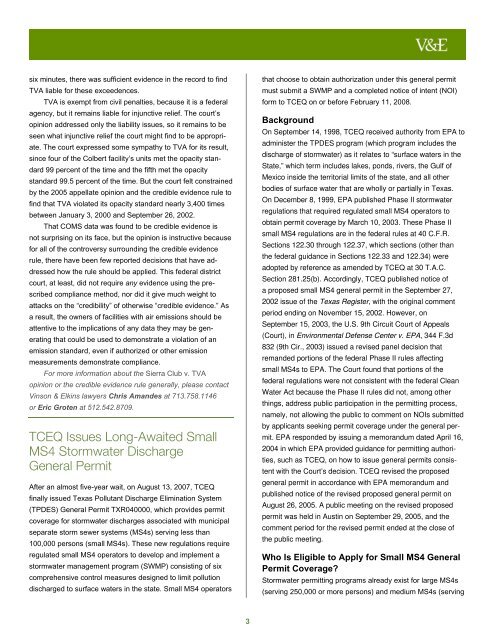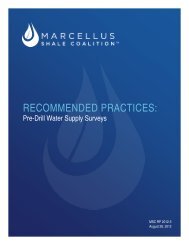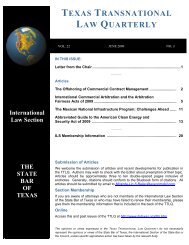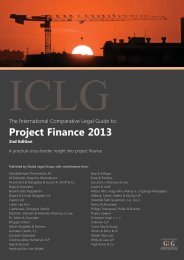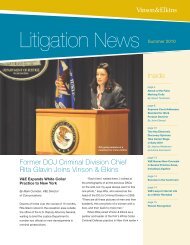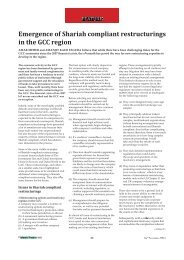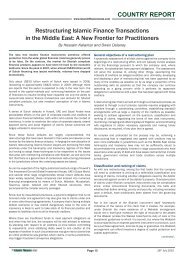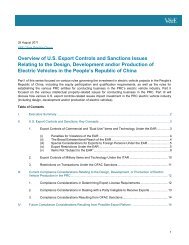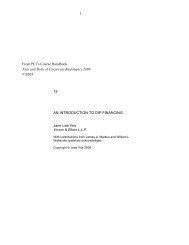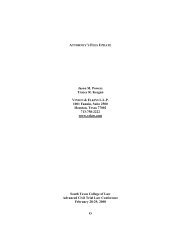Environmental News - Vinson & Elkins LLP
Environmental News - Vinson & Elkins LLP
Environmental News - Vinson & Elkins LLP
You also want an ePaper? Increase the reach of your titles
YUMPU automatically turns print PDFs into web optimized ePapers that Google loves.
six minutes, there was sufficient evidence in the record to find<br />
TVA liable for these exceedences.<br />
TVA is exempt from civil penalties, because it is a federal<br />
agency, but it remains liable for injunctive relief. The court’s<br />
opinion addressed only the liability issues, so it remains to be<br />
seen what injunctive relief the court might find to be appropriate.<br />
The court expressed some sympathy to TVA for its result,<br />
since four of the Colbert facility’s units met the opacity standard<br />
99 percent of the time and the fifth met the opacity<br />
standard 99.5 percent of the time. But the court felt constrained<br />
by the 2005 appellate opinion and the credible evidence rule to<br />
find that TVA violated its opacity standard nearly 3,400 times<br />
between January 3, 2000 and September 26, 2002.<br />
That COMS data was found to be credible evidence is<br />
not surprising on its face, but the opinion is instructive because<br />
for all of the controversy surrounding the credible evidence<br />
rule, there have been few reported decisions that have addressed<br />
how the rule should be applied. This federal district<br />
court, at least, did not require any evidence using the prescribed<br />
compliance method, nor did it give much weight to<br />
attacks on the “credibility” of otherwise “credible evidence.” As<br />
a result, the owners of facilities with air emissions should be<br />
attentive to the implications of any data they may be generating<br />
that could be used to demonstrate a violation of an<br />
emission standard, even if authorized or other emission<br />
measurements demonstrate compliance.<br />
For more information about the Sierra Club v. TVA<br />
opinion or the credible evidence rule generally, please contact<br />
<strong>Vinson</strong> & <strong>Elkins</strong> lawyers Chris Amandes at 713.758.1146<br />
or Eric Groten at 512.542.8709.<br />
TCEQ Issues Long-Awaited Small<br />
MS4 Stormwater Discharge<br />
General Permit<br />
After an almost five-year wait, on August 13, 2007, TCEQ<br />
finally issued Texas Pollutant Discharge Elimination System<br />
(TPDES) General Permit TXR040000, which provides permit<br />
coverage for stormwater discharges associated with municipal<br />
separate storm sewer systems (MS4s) serving less than<br />
100,000 persons (small MS4s). These new regulations require<br />
regulated small MS4 operators to develop and implement a<br />
stormwater management program (SWMP) consisting of six<br />
comprehensive control measures designed to limit pollution<br />
discharged to surface waters in the state. Small MS4 operators<br />
that choose to obtain authorization under this general permit<br />
must submit a SWMP and a completed notice of intent (NOI)<br />
form to TCEQ on or before February 11, 2008.<br />
Background<br />
On September 14, 1998, TCEQ received authority from EPA to<br />
administer the TPDES program (which program includes the<br />
discharge of stormwater) as it relates to “surface waters in the<br />
State,” which term includes lakes, ponds, rivers, the Gulf of<br />
Mexico inside the territorial limits of the state, and all other<br />
bodies of surface water that are wholly or partially in Texas.<br />
On December 8, 1999, EPA published Phase II stormwater<br />
regulations that required regulated small MS4 operators to<br />
obtain permit coverage by March 10, 2003. These Phase II<br />
small MS4 regulations are in the federal rules at 40 C.F.R.<br />
Sections 122.30 through 122.37, which sections (other than<br />
the federal guidance in Sections 122.33 and 122.34) were<br />
adopted by reference as amended by TCEQ at 30 T.A.C.<br />
Section 281.25(b). Accordingly, TCEQ published notice of<br />
a proposed small MS4 general permit in the September 27,<br />
2002 issue of the Texas Register, with the original comment<br />
period ending on November 15, 2002. However, on<br />
September 15, 2003, the U.S. 9th Circuit Court of Appeals<br />
(Court), in <strong>Environmental</strong> Defense Center v. EPA, 344 F.3d<br />
832 (9th Cir., 2003) issued a revised panel decision that<br />
remanded portions of the federal Phase II rules affecting<br />
small MS4s to EPA. The Court found that portions of the<br />
federal regulations were not consistent with the federal Clean<br />
Water Act because the Phase II rules did not, among other<br />
things, address public participation in the permitting process,<br />
namely, not allowing the public to comment on NOIs submitted<br />
by applicants seeking permit coverage under the general permit.<br />
EPA responded by issuing a memorandum dated April 16,<br />
2004 in which EPA provided guidance for permitting authorities,<br />
such as TCEQ, on how to issue general permits consistent<br />
with the Court’s decision. TCEQ revised the proposed<br />
general permit in accordance with EPA memorandum and<br />
published notice of the revised proposed general permit on<br />
August 26, 2005. A public meeting on the revised proposed<br />
permit was held in Austin on September 29, 2005, and the<br />
comment period for the revised permit ended at the close of<br />
the public meeting.<br />
Who Is Eligible to Apply for Small MS4 General<br />
Permit Coverage?<br />
Stormwater permitting programs already exist for large MS4s<br />
(serving 250,000 or more persons) and medium MS4s (serving<br />
3


